Railway corridors for intermodal transport run through the territory of the Baltic States, connecting eastern Europe with the west, north and south, thus linking Russia and East Asia with western Europe[1]. The railway network in the Baltic Sea Region is characterized by one of the highest capacities in freight traffic in Europe. Of great importance for intermodal transport is the development of the railway network within the framework of the north-south international rail link Rail Baltica, which is expected to contribute to an increase in the quality of connections and the efficiency of the connection between the Baltic States[2]. Therefore, only the full implementation of Rail Baltica will enable easy movement of goods and services by rail between the Baltic States. The direct connection between Western and Central Europe including the Baltic States is a very important hub for land connections to eastern and northern markets such as China and Asia. It should be taken into account that rail transport plays a major role in the Baltic States. The extent to which it is used varies from country to country, e.g., in Poland road transport dominates in international traffic, whereas rail has a larger share in domestic freight transport. In Germany the distribution of transport tasks in international traffic is the most even[3].
Figure 9.6. shows that the countries like Germany, Lithuania or Latvia have more services with countries outside the BSR. On the other hand, the countries Estonia, Poland, Denmark, Russia, and Sweden have more services within the BSR, but in Sweden and Russia domestic traffic dominates.
[1] A. Kuczyńska-Zonik, Bałtycki hub transportowy, [w:] Komentarze IEŚ, Nr 219 (122/2020), 16.07.2020
[2] J. Nazarko, J. Urban, Projekt Rail Baltica Growth Corridor w rozwoju usług logistycznych Rail Baltica Growth Corridor project in logistic services development, p. 5.
http://yadda.icm.edu.pl/baztech/element/bwmeta1.element.baztech-article-BPBB-0003-0007
[3] North Sea – Baltic Sea. TEN-T corridors network, 2018, p. 22.

9.4.1 Denmark
The main role in rail transport in Denmark is played by passenger traffic, but there is also freight traffic, mainly on international routes to Germany and Sweden. Freight transport in Denmark is operated by 3 railway operators. The first of these, DB Cargo, operates 1 domestic container service. The second operator, Kombiverkehr, carries combined freight, of which 1 service is domestic and 1 international and in both cases the terminal of origin is Fredericia. The third operator is among the global operators Hupac Intermodal, which offers 1 service named Fredericia-Milano in combined transport technology outside the BSR Region. The country of destination is Italy. It is worth mentioning here that the predominant terminal of origin is Fredericia. The existing CT network of Denmark can be seen on the Figure 9.7.
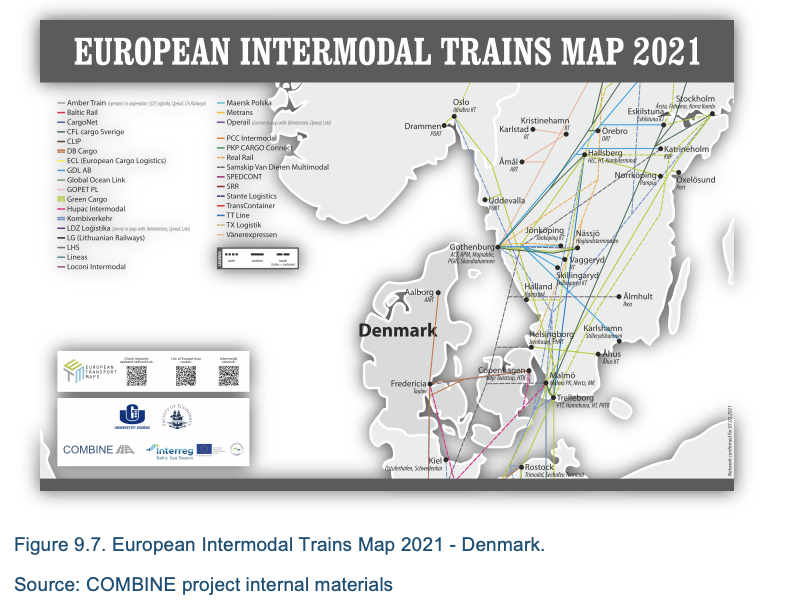
9.4.2 Estonia
In Estonia container freight transport is served by one main operator called Amber Train, which operates four Amber Train Option 1-4 services. Two of these services are local, with the start terminal being Tallinn and the terminals being Tartu and Sillamäe respectively. The other two are international lines, where the starting terminal is also Tallinn and the terminals are Šeštokai. Figure 9.8 shows that the dominant terminal in Estonia is Talin, while the service type is containerized. The importance of the terminal in Tallinn is even greater as there are two interconnected seaports. One is the old port of Tallinn (Vanasadam), which handles mainly passenger flows and ro-pax ferries and to some extent freight traffic. However, it is not connected to the railway in any way. The second port is the freight port of Muuga, which is connected to the railway network with a track gauge of 1520 mm. The Rail Baltica Corridor project envisages the port of Muuga to be included in the network and connected by a track gauge of 1435 mm. In Estonia, rail-road terminals operate alongside ports, but they are not stand-alone terminals. There are plans to build a dry port (rail-road terminal) on the outskirts of Tallinn in Ülemiste.[1]
[1] North Sea – Baltic Sea. TEN-T corridors network, 2018, p. 19, 38.
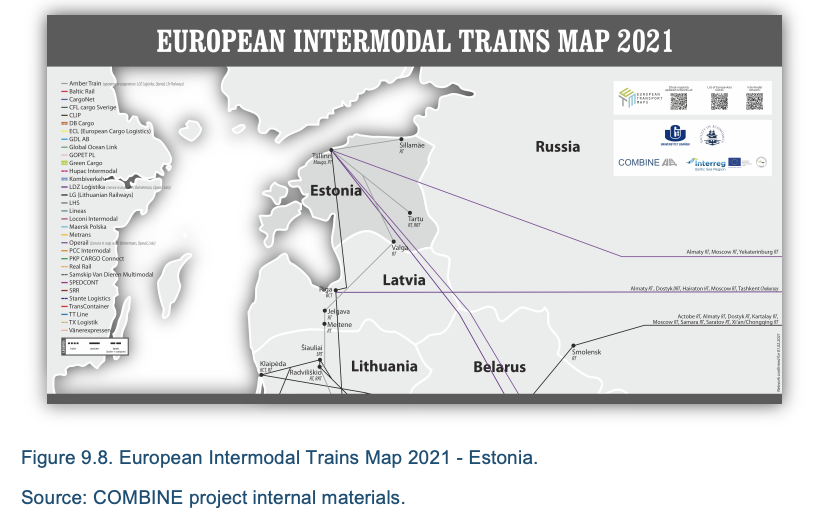
9.4.3 Germany
In Germany, cargo transport is handled by 8 operators that offer national and international services. Container services are operated by the following operators: DB Cargo, Metrans and PCC Intermodal. The first one called DB Cargo operates 9 service lines, 4 of which are in the BSR Region and 5 to non-Baltic countries, namely Italy and the Czech Republic. The second operator is Metrans, which operates 6 domestic service lines, where the main terminals of origin are Hamburg, Bremerhaven and München and 9 international lines, where the end countries are Czech Republic, Slovakia and Poland. The third operator is PCC Intermodal, which operates 3 service lines. One of them is a domestic line and two, whose end country is Belarus. Additionally, the operator ECL European Cargo Logistics operates 5 combined transport services, including 3 domestic and 2 international. Another global operator Hupac Intermodal operates 29 service lines, including 10 to the Baltic States and 19 outside the BSR region, where Italy is the dominant end country. Three further operators handle combined transport cargoes. These are the operator Kombiverkehr offering 66 service lines, Samskip Van Dieren Multimodal offering 10 service lines including 7 to countries in the BSR Region and the operator TX Logistik offering 23 services including 10 domestic. Figure 9.9 shows that the dominant terminals are those located in the ports of Hamburg, Hannover, Berlin, Bremen, Bremerhaven, Dortmund and Cologne, which have the character of tri-modal terminals with a well-developed rail-road terminal network.
Germany has four seaports located within the corridor: Hamburg, Bremerhaven, Bremen and Wilhelmshaven, which are connected by rail. It is worth mentioning that all ports have at least one terminal with open access for all operators[1].
[1] North Sea – Baltic Sea. TEN-T corridors network, 2018, p. 38.
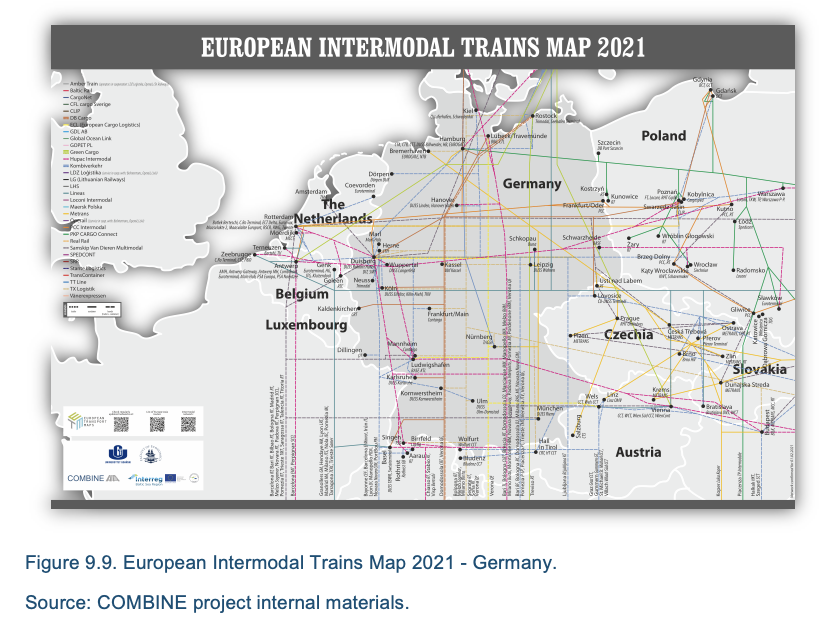
9.4.4 Finland
In Helsinki, the west port and south port, located in the city centre, form part of the combined Port of Helsinki. These ports mainly handle passenger ferries and ro-pax ferries and to some extent freight traffic. In contrast, the third Port of Vuosaari is connected to the railway. It is the new Vuosaari cargo port located east of the city and handles mainly cargo traffic (Figure 9.10).

9.4.5 Lithuania
In Lithuania, container cargo transport is handled by one main operator called LG (Lithuanian Railways), which operates 10 services, including 1 domestic, 3 in the Baltic Sea area and 6 outside the Baltic States. The terminals within the BSR are Moscow, Smolensk and Tallinn. Whereas the terminal countries within the international connections are Ukraine, Kazakhstan and China. From Figure 9.11 it can be seen that the predominant starting terminal for all connections is Klaipėda, where the seaport is located. It is a large non-freezing port on the east coast of the Baltic Sea with well-developed rail connections to inland areas. It is also Lithuania’s most important and largest transport hub, connecting sea, road, rail routes from east to west. The Public Logistics Centre, which is being built there, will contribute to increasing the competitive advantage of the region, including railways. It is worth mentioning that two independent rail-road terminals have been completed in Lithuania – in Vilnius and Kaunas.
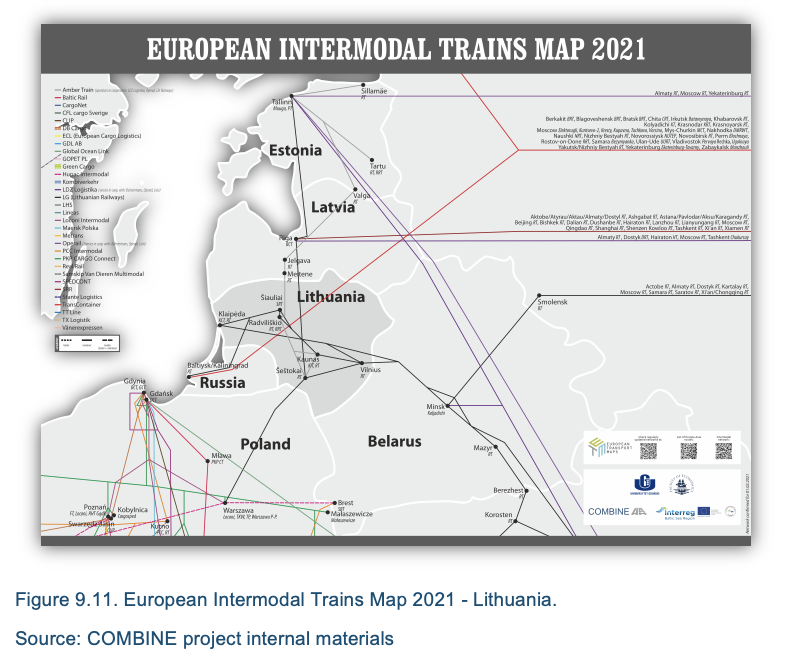
8.4.6 Latvia
In Latvia, container cargo transport is operated by two operators. The first one named LDZ Loģistika operates four Baltic Transit 1 service lines and one named Riga Express. All of them are international in character. The second operator is SRR, which operates 14 service lines of international character to countries outside the BSR Region and these are mainly Asian countries. From Figure 9.12 it can be seen that the dominant terminal in Latvia is Riga, while the service type is containerised. The Free Port of Riga is also located in Riga, which is the largest port in the Baltic States and it is connected to the railway network. Freight traffic in Riga is carried out on local roads which have limited capacity, therefore it is envisaged to connect the port directly to the TEN-T network via the Northern Riga Transport Corridor, including improved rail access to the port. The construction of the Rail Baltica railway line also envisages connecting the port to the future intermodal transport terminal near Salaspils. Another Latvian port is the non-freezing Vindava Freeport, which has convenient road and rail access[1].
[1] North Sea – Baltic Sea. TEN-T corridors network, 2018, p. 31.

9.4.7 Poland
In Poland containerized cargo transport is served by one operator Baltic Rail, which operates two services. The first one called Baltic Trains is a domestic service, with Gdynia as the departure terminal and Wroclaw as the destination terminal. The second service called Adriatic Trains is an international service with Katowice as the starting point and Koper in Slovenia as the terminus. From the figure 9.13 it can be seen that the dominant terminal in Poland is Gdynia, while the service type is container terminal. The three main areas for the location of rail-road terminals are Poznań, Łódź and Warsaw. They are conveniently located at the intersections of two TEN-T corridors (Baltic Sea – Adriatic Sea and North Sea – Baltic Sea corridors).
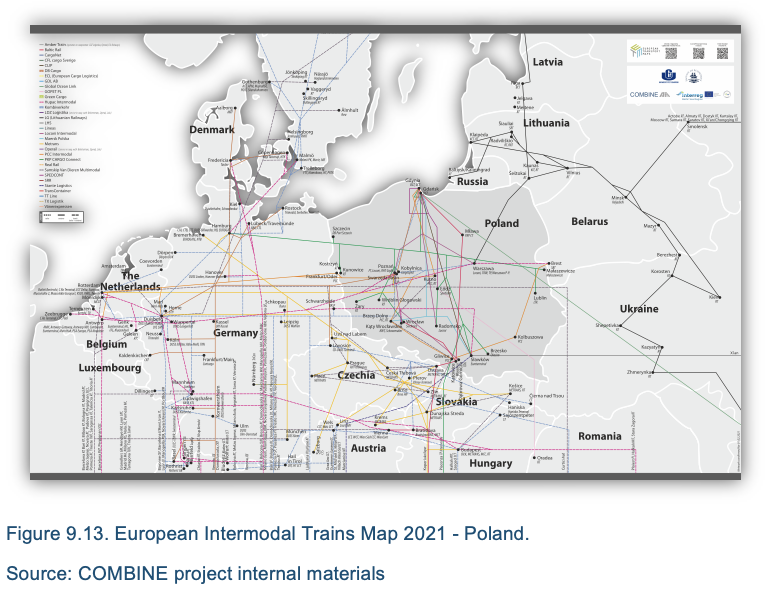
9.4.8 Russia
In Russia, container cargo transport is handled by two operators. The first one called Ruscon operates five service lines of domestic nature, where the main terminals of origin are Novorossiysk and Moscow, as can be seen from Figure 9.14. The second operator is TransContainer, which operates 56 service lines that are also domestic in nature, where the main terminals of origin are St. Petersburg, Moscow, Yekaterinburg and Novosibirsk.
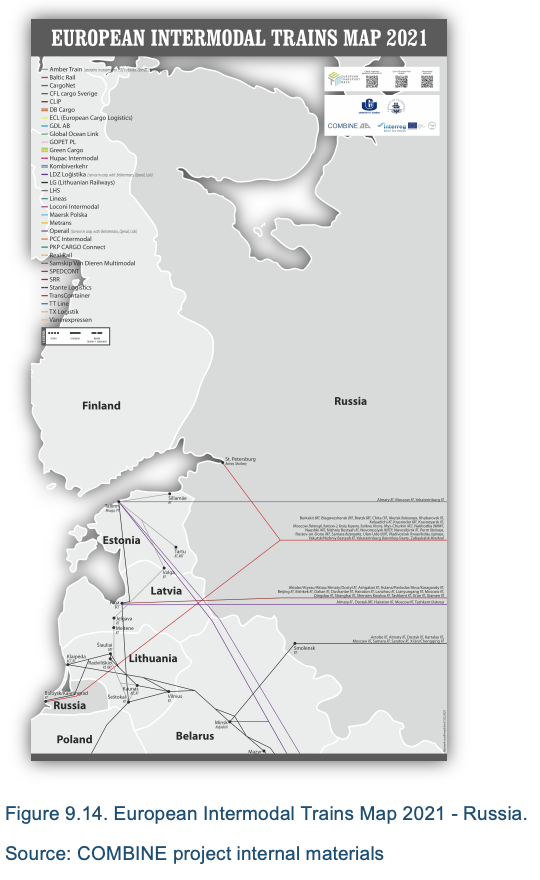
9.4.9 Sweden
In Sweden, cargo transport is handled by eight operators that offer domestic services. Container services are operated by the following operators: CFL Cargo Sverige, GDL AB, Metrans, TT-Line and Vänerexpressen. The first operator called CFL Cargo Sverige operates 8 domestic service lines with the main terminals of departure being Gothenburg and Malmö/Trelleborg. The second operator is GDL AB, which operates 8 domestic service lines with Gothenburg as the main terminal of departure. The third operator is Metrans, which operates one service line with the start terminal in Koper and the end terminal in Budapest. Another container freight operator is TT-Line, which operates a domestic line with a starting terminal in Trelleborg. The last container-only operator is Vänerexpressen, which offers two service lines with a starting terminal in Gothenburg. Additionally, the operator Green Cargo operates 10 container services, 6 combined transport services and 1 trailer. Two further operators handle cargo in combined transport. These are the operator Kombiverkehr with 6 domestic service lines and the operator Real Rail with 10 service lines. Figure 9.15 shows that the dominant terminals in Sweden are Geteborg and Malmo.
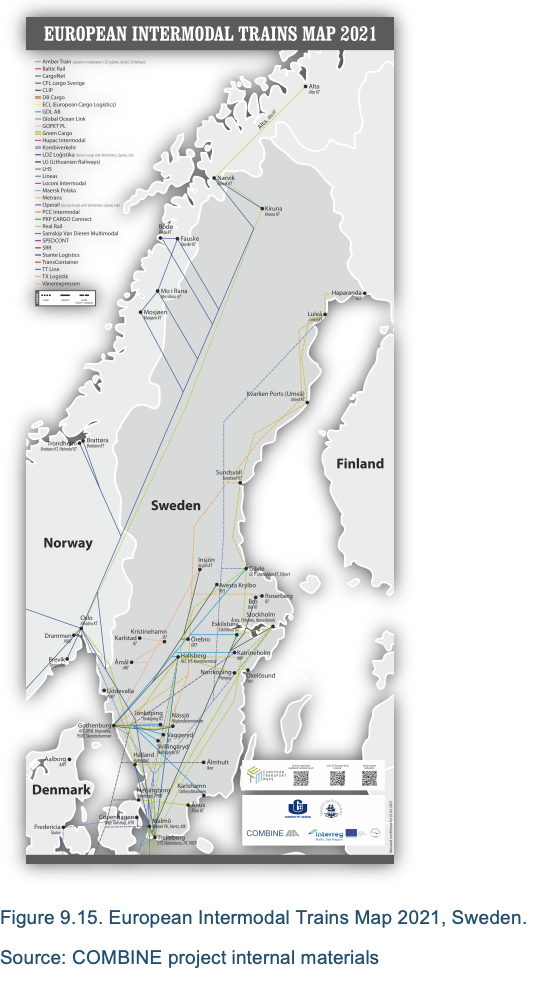
9.4.10 BSR in the New Silk Road corridor
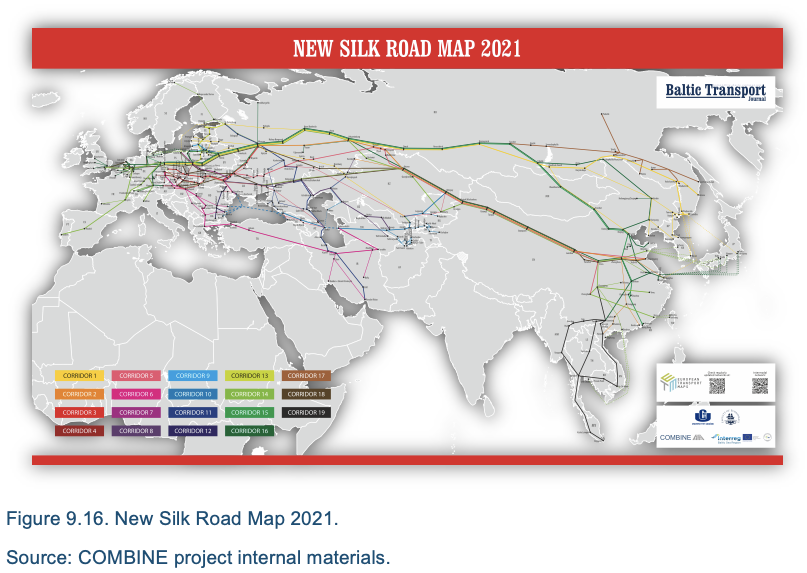
The BSR is in a special location regarding the trans-continental trade and is the crucial area of the New Silk Road (NSR) connecting East Asia and Europe. As from Figure 9.16 can be seen, there are some links going via the Middle East and Turkey but, the main corridor leads via the Belarus and Poland to Germany towards the Netherlands and Belgium. Not only due to the capacity of specific rail track, but also due to some local obstacles (like in Malaszewicze), some new routes are being developed in the general framework of the NSR (vide: Klaipeda or Ventspils nodes-based alternatives). This gives the region another impulse for the development of the CT network with a more global perspective and dimension. Yearly container traffic on the NSR does not exceed 350,000 TEU and 2 million tonnes and the growth rate gives not any justification to expect that in some day this corridor overtakes the role fo the container shipping. But, even the current dimension of the container traffic being realized on the NSR should give the impulse to the additional function that the CT network of the BSR should play as a transit system to themselves and to the western part of Europe.